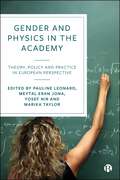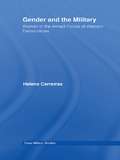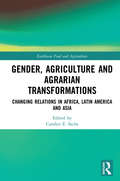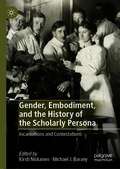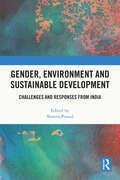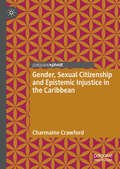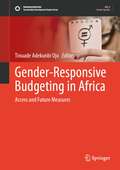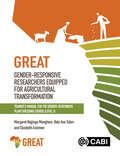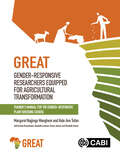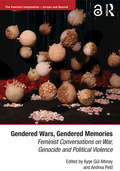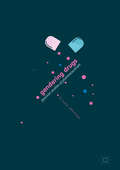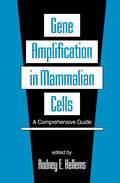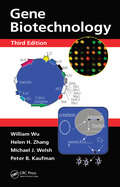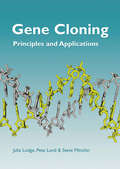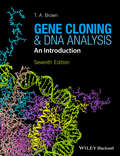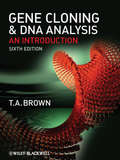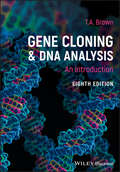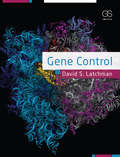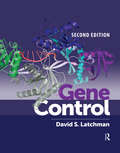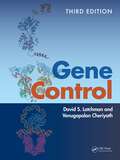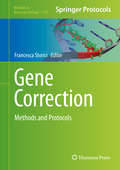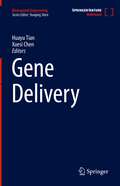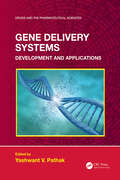- Table View
- List View
Gender and Physics in the Academy: Theory, Policy and Practice in European Perspective
by Pauline Leonard, Meytal Eran Jona, Yosef Nir, and Marika TaylorThis innovative interdisciplinary collection confronts the worldwide challenge of women's under-representation in science through an interrogation of the field of physics and its gender imbalance. Leading physicists and sociologists from across Europe collaborate to adopt a comparative approach. They draw on theoretical perspectives and empirical evidence to explore the reasons behind low participation levels, from entering the field to sustaining a career, emphasising the importance of social perspectives over biological explanations. Evaluating policy solutions implemented in various European contexts, this book offers key insights into the world of women physicists and sheds light on their life stories.
Gender and Sexuality: Critical Theories, Critical Thinkers
by Chris BeasleyThis accessible introduction to gender and sexuality theory offers a comprehensive overview and critique of the key contemporary literature and debates in feminism, sexuality studies and men's studies. Chris Beasley's clear and concise introduction combines a wide-ranging survey of the major theorists and key concepts in an ever-growing and often passionately debated field. The book contextualizes a wide range of feminist perspectives, including: modernist, liberal, postmodern, queer and gender difference feminism; and in the realm of sexuality studies covers modernist liberationism, social constructionism, transgender theorising and queer theory. In men's studies, Chris Beasley examines areas of debate ranging from gender and masculinity to questions of race, ethnicity, imperialism and gay masculinities. Interconnections between the subfields are highlighted, and Beasley considers the implications of body theory for all three. Key theorists covered include: Altman· Brod· Butler · Califia· Carbado· Connell· Dowsett ·Grosz· Halberstam· Hook · Jackson· Jagose· Nussbaum· Rich· Seidman· Spivak· Stoltenberg· Weeks· Whittle· Wolf· Wollstonecraft The only book of its kind to draw together all the important strands of gender analysis, Gender and Sexuality is a timely and impressive overview that is invaluable to students and academics taking courses on gender and feminist theory, sexuality and masculinity.
Gender and the Military: Women in the Armed Forces of Western Democracies (Cass Military Studies)
by Helena CarreirasThis is the first comparative, cross-national study of the participation of women in the armed forces of NATO countries. Along side an analysis of this key topic stands a critique of existing theoretical models and the proposal of a revised analytical framework. Unlike previous works this new study employs mixed-methodological research design combining quantitative and qualitative data - a large N-analysis based on general policies and statistical information concerning every country in the sample with more in-depth case-studies. This volume includes original empirical data regarding the presence of women in the armed forces of NATO countries, proposes an index of ‘gender inclusiveness’ and assesses the factors that affect women’s military roles. The book also presents two new key case studies – Portugal and the Netherlands - based on both documentary sources and in-depth interviews of both men and women officers in the two countries. This book will be of great interest to all students and scholars of strategic studies, gender and women studies and military history.
Gender, Agriculture and Agrarian Transformations: Changing Relations in Africa, Latin America and Asia (Earthscan Food and Agriculture)
by Carolyn E. SachsThis book presents research from across the globe on how gender relationships in agriculture are changing. In many regions of the world, agricultural transformations are occurring through increased commodification, new value-chains, technological innovations introduced by CGIAR and other development interventions, declining viability of small-holder agriculture livelihoods, male out-migration from rural areas, and climate change. This book addresses how these changes involve fluctuations in gendered labour and decision making on farms and in agriculture and, in many places, have resulted in the feminization of agriculture at a time of unprecedented climate change. Chapters uncover both how women successfully innovate and how they remain disadvantaged when compared to men in terms of access to land, labor, capital and markets that would enable them to succeed in agriculture. Building on case studies from Africa, Latin America and Asia, the book interrogates how new agricultural innovations from agricultural research, new technologies and value chains reshape gender relations. Using new methodological approaches and intersectional analyses, this book will be of great interest to students and scholars of agriculture, gender, sustainable development and environmental studies more generally.
Gender, Embodiment, and the History of the Scholarly Persona: Incarnations and Contestations
by Kirsti Niskanen Michael J. BaranyThis book investigates the historical construction of scholarly personae by integrating a spectrum of recent perspectives from the history and cultural studies of knowledge and institutions. Focusing on gender and embodiment, the contributors analyse the situated performance of scholarly identity and its social and intellectual contexts and consequences. Disciplinary cultures, scholarly practices, personal habits, and a range of social, economic, and political circumstances shape the people and formations of modern scholarship. Featuring a foreword by Ludmilla Jordanova, Gender, Embodiment, and the History of the Scholarly Persona: Incarnations and Contestations is of interest to historians, sociologists, media and culture scholars, and all those with a stake in the personal dimensions of scholarship. An international group of scholars present original examinations of travel, globalisation, exchange, training, evaluation, self-representation, institution-building, norm-setting, virtue-defining, myth-making, and other gendered and embodied modes and mechanisms of scholarly persona-work. These accounts nuance and challenge existing understandings of the relationship between knowledge and identity.
Gender, Environment and Sustainable Development: Challenges and Responses from India
by Shweta PrasadThis book studies environment and sustainable development from the perspective of gender. It focuses on three major themes, including sustainability of development practices, policy perspectives on environmental management and climate change and its gendered impact. It includes contributions from academicians working across disciplines and practitioners working at the grassroots levels. The book addresses issues facing India amid a growing global environmental crisis and suggests policy measures for environmental protection and to improve the quality of life of its inhabitants. Lucid and topical, the volume will be an indispensable resource for students, researchers of gender, environment and sustainable development, sociology and public policy. It will also be a great resource for advocacy groups, non-governmental organisations (NGOs) and policymakers working in the area.
Gender, Sexual Citizenship and Epistemic Injustice in the Caribbean
by Charmaine CrawfordThis book interrogates the relationship between gender, sexual citizenship and epistemic injustice as it relates to the experiences of LGBTQ persons in the Commonwealth Caribbean. Whether it is the recognition of gender/sexual identities, sexual freedom, bodily autonomy, marriage or creating a family, sexual citizenship encompasses different aspects of our intimate lives that have erotic, social, and economic value that are organised and legitimised through the family, religion, law, state, family, and civil society. Employing decolonial feminist queer perspectives, this book considers how race, gender, and sexuality intersect through matrices of power in shaping intimate life in giving more rights and freedoms to some over others. While Caribbean sexualities are rich and diverse, there still exists dominant colonial and post-colonial heteropatriarchal ideologies and practices that infringe on the sexual rights of Caribbean LGBTQ persons normalising discriminatory treatment (homophobia, lesbophobia and transphobia) against them. Despite efforts to silence Caribbean LGBTQ persons, they have politicised their cause by engaging in epistemic resistance. Caribbean LGBTQ activism encompasses a myriad of social justice efforts, incorporating intersectional politics with feminists and other groups, which validate queer identities, knowledges and lives in the region and diaspora. This book showcases how Caribbean LGBTQ activists are using strategic litigation anchored in social justice hermeneutics to upend vagrancy and anti-buggery laws, which has led to successful decriminalisation cases in the region. This book will interest researchers and students in women’s, gender, and sexuality studies and Caribbean studies.
Gender-Responsive Budgeting in Africa: Access and Future Measures (Sustainable Development Goals Series)
by Tinuade Adekunbi OjoAfrica is the leading region in the world in the expansion of mobile money transactions, according to Global Findex. The book presents several significant themes and African states' efforts to address the political and economic factors influencing budget allocation to women-oriented programmes and projects in African communities. The book further investigates the impact of gender-responsive budgeting on women's empowerment and gender equality in these communities. The findings intend to analyse the effectiveness of the countries' approaches and share lessons that different African economies, whether currently booming or struggling, can enhance or implement toward gender budgeting response at all structural levels. Gender budgeting is an important tool in response to the growth and development of the economy. The themes identified will guide gender budgeting response, and how gender is incorporated into these approaches (if at all). The main objective of this volumeis to understand different processes of gender budgeting in response to gender issues at a national level. And to help encourage reflection on what lessons could be learnt between states and what factors cause divergence in multilateral settings so that they can be understood and hopefully addressed.
Gender-responsive Researchers Equipped for Agricultural Transformation, Level 2.: Trainer’s Manual for the Gender-Responsive Plant Breeding Course
by Dr Margaret Najjingo Mangheni Professor Hale Ann Tufan Dr Elizabeth AsiimweThis manual presents the training process for the Gender-Responsive Plant Breeding course, implemented by Makerere and Cornell Universities, over a period of five years (2016-2020), under the Gender-Responsive Researchers Equipped for Agricultural Transformation (GREAT) project funded by the Bill and Melinda Gates Foundation. It has five broad parts: I) Introduction; II) Required preparation before the course; III) Phase one (9-day, face-to-face training); IV) the 5-month Field Training phase; and V) Phase two (5-day, face-to-face training). Each session consists of specific learning objectives, session plans and slides, delivery methods, practical exercises and examples, as well as relevant tips and synthesized take-home messages. The sessions were developed by an international multidisciplinary team of experts in gender and agriculture and subjected to a rigorous peer review and quality assurance process. GREAT aims to contribute to building a pool of gender-responsive agricultural researchers able to advance more equitable and effective agricultural systems in Africa and beyond. This manual is for all facilitators/trainers interested in applied, gender responsive agricultural research.
Gender-responsive Researchers Equipped for Agricultural Transformation: Trainer’s Manual for the Gender-Responsive Plant Breeding Course
by Dr Margaret Najjingo Mangheni Professor Hale Ann TufanThis manual presents the training process for the Gender-Responsive Plant Breeding course, implemented by Makerere and Cornell Universities, over a period of five years (2016-2020), under the Gender-Responsive Researchers Equipped for Agricultural Transformation (GREAT) project funded by the Bill and Melinda Gates Foundation. It has five broad parts: I) Introduction; II) Required preparation before the course; III) Phase one (9-day, face-to-face training); IV) the 5-month Field Training phase; and V) Phase two (5-day, face-to-face training). Each session consists of specific learning objectives, session plans and slides, delivery methods, practical exercises and examples, as well as relevant tips and synthesized take-home messages. The sessions were developed by an international multidisciplinary team of experts in gender and agriculture and subjected to a rigorous peer review and quality assurance process. GREAT aims to contribute to building a pool of gender-responsive agricultural researchers able to advance more equitable and effective agricultural systems in Africa and beyond. This manual is for all facilitators/trainers interested in applied, gender responsive agricultural research.
Gendered Wars, Gendered Memories: Feminist Conversations on War, Genocide and Political Violence (The Feminist Imagination - Europe and Beyond)
by Ayşe Gül AltinayThe Introduction of this book is freely available as a downloadable Open Access PDF under a Creative Commons Attribution-Non Commercial-No Derivatives 4.0 license available at http://www.taylorfrancis.com/books/e/9781315584225 The twentieth century has been a century of wars, genocides and violent political conflict; a century of militarization and massive destruction. It has simultaneously been a century of feminist creativity and struggle worldwide, witnessing fundamental changes in the conceptions and everyday practices of gender and sexuality. What are some of the connections between these two seemingly disparate characteristics of the past century? And how do collective memories figure into these connections? Exploring the ways in which wars and their memories are gendered, this book contributes to the feminist search for new words and new methods in understanding the intricacies of war and memory. From the Italian and Spanish Civil Wars to military regimes in Turkey and Greece, from the Armenian genocide and the Holocaust to the wars in Abhazia, East Asia, Iraq, Afghanistan, former Yugoslavia, Israel and Palestine, the chapters in this book address a rare selection of contexts and geographies from a wide range of disciplinary perspectives. In recent years, feminist scholarship has fundamentally changed the ways in which pasts, particularly violent pasts, have been conceptualized and narrated. Discussing the participation of women in war, sexual violence in times of conflict, the use of visual and dramatic representations in memory research, and the creative challenges to research and writing posed by feminist scholarship, Gendered Wars, Gendered Memories will appeal to scholars working at the intersection of military/war, memory, and gender studies, seeking to chart this emerging territory with ’feminist curiosity’.
Gendering Drugs: Feminist Studies of Pharmaceuticals
by Ericka JohnsonThis book, by bringing together critical pharmaceutical studies and feminist technoscience studies, explores the way drugs produce sexed and/or gendered identities for those who take – or resist – them, and how feminist technoscience studies can contribute a theoretical lens with which to observe sex and gender in the pharmaceuticalization processes. Topics explored in this diverse collection include the use of hormones to delay puberty onset for trans children; HPV vaccination against cervical cancer in Sweden, the UK, Austria and Colombia; Alzheimer’s discourses; and the medication of prostate issues. Ericka Johnson has brought together an innovative and timely collection that demonstrates gender as relevant in studies of pharmaceuticals, and provides multiple examples of methodological and theoretical tools to consider gender while studying drugs.
Gene Amplification in Mammalian Cells: A Comprehensive Guide
by Rodney E. KellemsServes as a comprehensive review to the substantial impact of gene amplification in molecular biology, genetic engineering and medical science. The book covers the mechanism of gene amplification, organization and structure of amplified genes.
Gene Biotechnology
by William Wu Helen H. Zhang Michael J. Welsh Peter B. KaufmanCovering state-of-the-art technologies and a broad range of practical applications, the Third Edition of Gene Biotechnology presents tools that researchers and students need to understand and apply today's biotechnology techniques. Many of the currently available books in molecular biology contain only protocol recipes, failing to explain the princ
Gene Cloning
by Julia Lodge Peter Lund Steve MinchinThe ability to successfully clone genes underlies the majority of our knowledge in molecular and cellular biology. Gene Cloning introduces the diverse array of techniques available to clone genes and how they can be used effectively both in the research laboratory, to gain knowledge about the gene, and for use in biotechnology, medicine, the pharmaceutical industry, and agriculture. It shows how cloning genes is an integral part of genomics and underlines its relevance in the post-genomic age, as a tool required to test predictions of gene regulation and function made through bioinformatics. Applications of gene cloning in medicine, both for diagnosis and treatment, and in the pharmaceutical industry and agriculture, are also covered in the book. Gene Cloning takes a fresh approach to teaching molecular and cellular biology and will be a valuable resource to both undergraduates and lecturers of biological and biomedical science courses.
Gene Cloning and Analysis: Current Innovations
by Brian C. SchaeferThis volume focuses on newly emerging technologies that facilitate the isolation and characterization of genes. The detailed protocols will be useful to the seasoned professional and easily understood by the novice. The vast majority of methods are applic
Gene Cloning and DNA Analysis
by T. A. BrownKnown world-wide as the standard introductory text to this important and exciting area, the sixth edition of Gene Cloning and DNA Analysis addresses new and growing areas of research whilst retaining the philosophy of the previous editions. Assuming the reader has little prior knowledge of the subject, its importance, the principles of the techniques used and their applications are all carefully laid out, with over 250 clearly presented four-colour illustrations.In addition to a number of informative changes to the text throughout the book, the final four chapters have been significantly updated and extended to reflect the striking advances made in recent years in the applications of gene cloning and DNA analysis in biotechnology.Gene Cloning and DNA Analysis remains an essential introductory text to a wide range of biological sciences students; including genetics and genomics, molecular biology, biochemistry, immunology and applied biology. It is also a perfect introductory text for any professional needing to learn the basics of the subject. All libraries in universities where medical, life and biological sciences are studied and taught should have copies available on their shelves."... the book content is elegantly illustrated and well organized in clear-cut chapters and subsections... there is a Further Reading section after each chapter that contains several key references... What is extremely useful, almost every reference is furnished with the short but distinct author's remark."-Journal of Heredity, 2007 (on the previous edition)
Gene Cloning and DNA Analysis: An Introduction
by T. A. BrownKnown world-wide as the standard introductory text to this important and exciting area, the sixth edition of Gene Cloning and DNA Analysis addresses new and growing areas of research whilst retaining the philosophy of the previous editions. Assuming the reader has little prior knowledge of the subject, its importance, the principles of the techniques used and their applications are all carefully laid out, with over 250 clearly presented four-colour illustrations. In addition to a number of informative changes to the text throughout the book, the final four chapters have been significantly updated and extended to reflect the striking advances made in recent years in the applications of gene cloning and DNA analysis in biotechnology. Gene Cloning and DNA Analysis remains an essential introductory text to a wide range of biological sciences students; including genetics and genomics, molecular biology, biochemistry, immunology and applied biology. It is also a perfect introductory text for any professional needing to learn the basics of the subject. All libraries in universities where medical, life and biological sciences are studied and taught should have copies available on their shelves. "… the book content is elegantly illustrated and well organized in clear-cut chapters and subsections… there is a Further Reading section after each chapter that contains several key references… What is extremely useful, almost every reference is furnished with the short but distinct author's remark." –Journal of Heredity, 2007 (on the previous edition)
Gene Cloning and DNA Analysis: An Introduction
by T. A. BrownKnown worldwide as the standard introductory text to this important and exciting area of study, Gene Cloning and DNA Analysis: An Introduction, 8th Edition preserves the tradition of excellence created by previous editions. Comprehensive and authoritative, the book explores all of the topics crucial to an understanding of gene cloning in an approachable way. An easy-to-follow and user-friendly layout is presented in full-color throughout the volume, making it simple to absorb the clear and accessible material contained within. Gene Cloning and DNA Analysis: An Introduction, 8th Edition contains updated and extended coverage of gene editing strategies like CRISPR/Cas, rewritten chapters on DNA sequencing and genome studies, as well as new material on real-time PCR and typing of human disease mutations. Over 250 full-color illustrations are included to bring to life the comprehensive content. The book also covers topics like: The strategies used by researchers and industry practitioners to assemble genome sequences Next generation sequencing methods and descriptions of their applications in studying genomes and transcriptomes Includes the use and application of gene editing strategies Interbreeding between Neanderthals and Homo Sapiens Gene Cloning and DNA Analysis: An Introduction, 8th Edition is an invaluable introductory text for students in classes like genetics and genomics, molecular biology, biochemistry, immunology, and applied biology. It also belongs on the bookshelves of every professional who desires to improve their understanding of the basics of gene cloning or DNA analysis.
Gene Control
by David LatchmanGene Control offers a current description of how gene expression is controlled in eukaryotes, reviewing and summarizing the extensive primary literature into an easily accessible format. Gene Control is a comprehensively restructured and expanded edition of Latchman’s Gene Regulation: A Eukaryotic Perspective, Fifth Edition. The first part of the book deals with the fundamental processes of gene control at the levels of chromatin structure, transcription, and post-transcriptional processes. Three pairs of chapters deal with each of these aspects, first describing the basic process itself, followed by the manner in which it is involved in controlling gene expression. The second part of the book deals with the role of gene control in specific biological processes. Certain chapters deal with the importance of gene control in cellular signaling processes and for normal development of the embryo. Another chapter discusses the key roles played by gene-regulatory processes in the specification of differentiated cell types such as muscle cells and neurons. The final chapters discuss the consequences of errors in gene control; the relationship between gene misregulation and human diseases, especially cancer; and potential therapies designed specifically to target particular levels of gene control. Gene Control will be of value to students in biological sciences, as well as to scientists and clinicians interested in how genes are regulated in health and disease.
Gene Control
by David LatchmanThe new edition of Gene Control has been updated to include significant advances in the roles of the epigenome and regulatory RNAs in gene regulation. The chapter structure remains the same: the first part consists of pairs of chapters that explain the mechanisms involved and how they regulate gene expression, and the second part deals with specific biological processes (including diseases) and how they are controlled by genes. Coverage of methodology has been strengthened by the inclusion more explanation and diagrams. The significant revision and updating will allow Gene Control to continue to be of value to students, scientists and clinicians interested in the topic of gene control.
Gene Control
by David S. Latchman Venugopalan CheriyathThe new edition of Gene Control, for the first time, provides extensive coverage on prokaryotic gene regulation, which makes it the only textbook offering a complete and detailed account of gene control for both prokaryotic and eukaryotic organisms. The core objective of this edition is to educate students about the fundamental principles and mechanisms governing gene expression, regulation, and function. To reinforce these ideas, each chapter now includes discussion questions to promote critical thinking. There are also multiple choice questions and animations for students, and a large question bank and figure slides for instructors. The textbook also emphasizes the vital role of scientific experiments and evidence in shaping our current understanding of gene control and provides comprehensive coverage of essential gene expression techniques and methodologies throughout the book.This extensively updated edition of the renowned textbook Gene Control will remain a valuable resource for students, instructors, researchers, and medical professionals exploring various aspects of gene control, ranging from the regulation of genes in infectious diseases to embryonic development across different organisms, from bacteria to humans.
Gene Correction
by Francesca StoriciGene correction is a technology that gives us the tools for both repairing and mutating DNA, for discovering gene functions and for engineering new genetic variants. Gene Correction: Methods and Protocols provides a user friendly, detailed and up-to-date collection of strategies and methodologies utilized for generating specific sequence changes in the DNA of cells in the laboratory, while also tackling the major problems that the field of gene correction faces. This volume brings together many experts in the field of gene correction to disclose a wide and varied array of specific gene correction protocols for engineering mutations in DNA, for delivering correcting DNA to target cells, and for improving the accuracy and safety of the gene correction process. Written in the successful Methods in Molecular Biology series format, chapters include introductions to their respective topics, lists of the necessary materials and reagents, step-by-step, readily reproducible protocols, and notes on troubleshooting and avoiding known pitfalls. Authoritative and easily accessible, Gene Correction: Methods and Protocols seeks to serve scientists of all backgrounds interested in the area of gene targeting/recombination/therapy.
Gene Delivery (Biomaterial Engineering)
by Huayu Tian Xuesi ChenGene therapy has been regarded as a great potential for specific treatment of gene-related human diseases, such as cancer, genetic and epidemic diseases. Gene therapy refers to the biomedical technology that inserts normal or therapeutic exogenous genes into target cells to repair or replace defective genes in target cells, so as to achieve the purpose of treating diseases. Efficient gene delivery systems are the crucial roles for successful implementation of gene therapy. This book provides a platform for young scholars and students to systematically understand the preparation and characterization of the existing non-viral gene delivery systems, as well as providing a technology platform for clinical gene therapy
Gene Delivery Systems: Development and Applications (ISSN)
by Yashwant V. PathakThis unique volume in our Drugs and Pharmaceutical Sciences series covers the development of gene therapy today, the technology involved, clinical applications of siRNA, non-viral vector-based mRNA delivery using nanotechnology, and RNA based vaccines for treating the infectious diseases. It also presents the current application of the CRISPR/Cas9 gene-editing technique which has revolutionized genome editing and which was awarded the 2020 Nobel Prize in Chemistry. Several new drug delivery systems are explored for the applications of gene therapy. These are found to be useful in treating chronic illnesses, including cancer and infectious diseases. Key Features: Overview of the development of gene therapy Provides the most up to date information on the development of gene therapy, from the technology involved to gene correction and genome editing Presents CRISPR gene therapy recent trends and applications Discusses siRNA, mRNA, and DNA plasmids
